Lesson plan 详细版汇编
- 格式:doc
- 大小:23.00 KB
- 文档页数:8
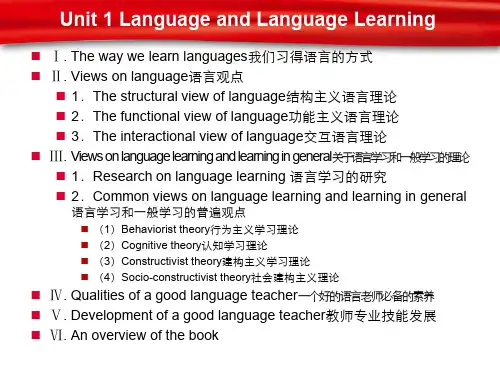
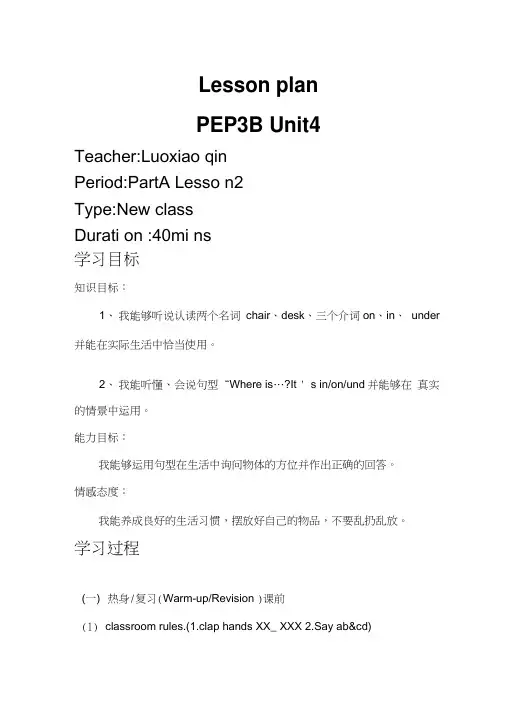
Lesson planPEP3B Unit4Teacher:Luoxiao qinPeriod:PartA Lesso n2Type:New classDurati on :40mi ns学习目标知识目标:1、我能够听说认读两个名词chair、desk、三个介词on、in、under 并能在实际生活中恰当使用。
2、我能听懂、会说句型“Where is…?It ' s in/on/und并能够在真实的情景中运用。
能力目标:我能够运用句型在生活中询问物体的方位并作出正确的回答。
情感态度:我能养成良好的生活习惯,摆放好自己的物品,不要乱扔乱放。
学习过程(一) 热身/复习(Warm-up/Revision )课前(1)classroom rules.(1.clap hands XX_ XXX 2.Say ab&cd)(2)Grouping(count froml to 6))(3) 1 wanna find which group is the champion.Ok, let ' s go. Fighting! Go go go !(二) 呈现新课(Presentation)15 '1) Greeting.Hi,Hello,Nice to meet you.2) Lind in: Today I ' m very glad to be your new English teacher. Do you want to know me? I ' m ofte n con fused. Because I am so busy. Look, this is my room. 展示PPT : Wow, That' s terrible.So,kids please help me to tidy my room. Will you? Ok ,let ' s go! 3) Study the new words desk and chair use phonics acti ons.T: What can you see in my room? What is it? It ' asdesk .教师用TPR和phonics教学生认读单词desk and chair.(操练这两个新单词。
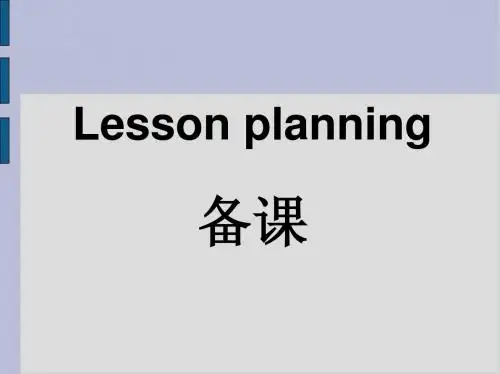
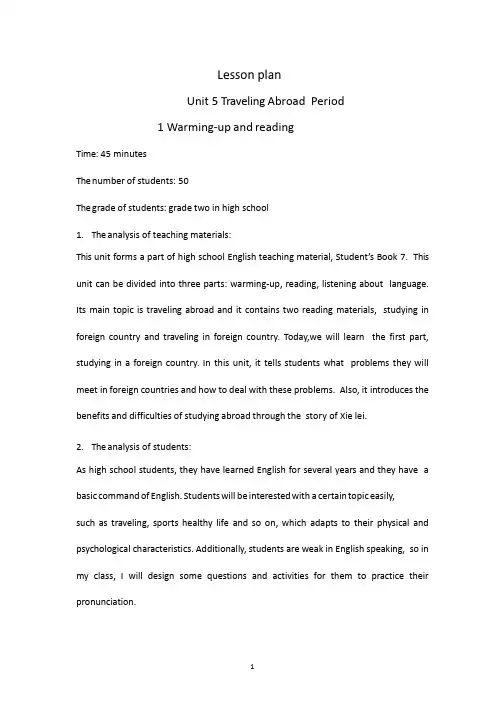
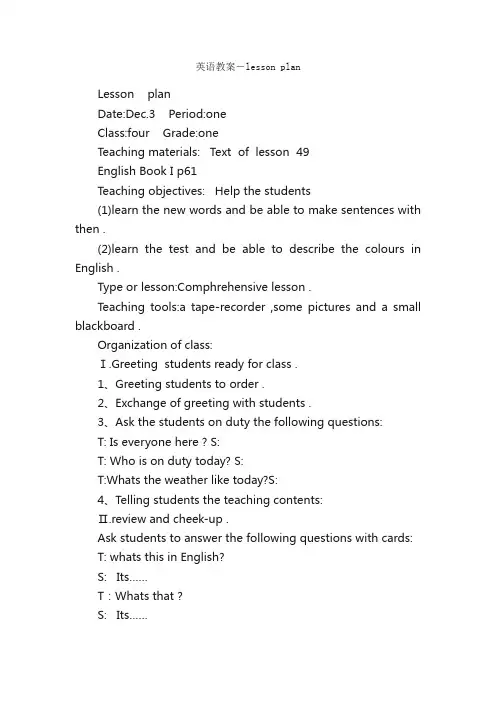
英语教案-lesson planLesson planDate:Dec.3 Period:oneClass:four Grade:oneTeaching materials: Text of lesson 49English Book I p61Teaching objectives: Help the students(1)learn the new words and be able to make sentences with then .(2)learn the test and be able to describe the colours in English .Type or lesson:Comphrehensive lesson .Teaching tools:a tape-recorder ,some pictures and a small blackboard .Organization of class:Ⅰ.Greeting students ready for class .1、Greeting students to order .2、Exchange of greeting with students .3、Ask the students on duty the following questions:T: Is everyone here ? S:T: Who is on duty today? S:T:Whats the weather like today?S:4、Telling students the teaching contents:Ⅱ.review and cheek-up .Ask students to answer the following questions with cards: T: whats this in English?S: Its……T:Whats that ?S: Its……T:Is this(that) a(an)……?S:Yes , it is ./No, it isn t .Ⅲ. Presentation of the new materials:1、Teching the following new words with a small blackboard .1)What colour is it ?(Teacher point to the pictures on the small blackboard)Itsblack/red/white/green/yellow/blue/purple/brown/orange/grey.( students read out aloud)2)Whats colour is it ? (Teacher point to the classroom in the picture)Its…(red) . (students read aloud)2、Teach the text:1)Put up some pictures and ask students to listen to the recording of the text while looking at the picture.(again and again)2)Ask the students some questions to cheek them .①Whats this (that) ?②Is this (that) a car ?③What colour is it ?④Its…(black) .Its a …(black) car .3)Explain some language points:①There is a car on the hill in the picture . (Explain why use "on" instead of "in")②A:what colour is it? B:Its black. Its a black car. (Extlain "black" and " a black car "the use of sentences) .Ⅳ. Reinforcement :1、Reading the text after the recording and the teacher gives some guideline to the pronuncition and intonation of reading the text .2、Ask students to read the text .3、Ask students to give some questions on the pictures and give answer.4、Play a game use pictures ( T : Act it.Ask students do it like this )Ⅴ. Summary:Today were learned some new words and the text please pay attention to those words in the text. (pointing to some important points)Ⅵ. Design for exercises:1、Homework:1)Revise the dialogues in lesson 49 .2)Write the new words .3)Finish the workbook esercises. Do Ex 2,3 in the exercise book .2、Additional exercises :A)词组互译:1、一只红色的风筝2、一朵黄色的花3、一辆蓝色的小汽车4、一只黑色的猫5、一只白色的鸟6、一个绿色的苹果B)Fill in the blank:A:Whats over there?B: ?A:Over there, the hill.B: a car.A: is it ?B:Its red. Its a red .A:Is a car , too ?B: , it is .A:What colour is it ?B:Its . Its a black car.。
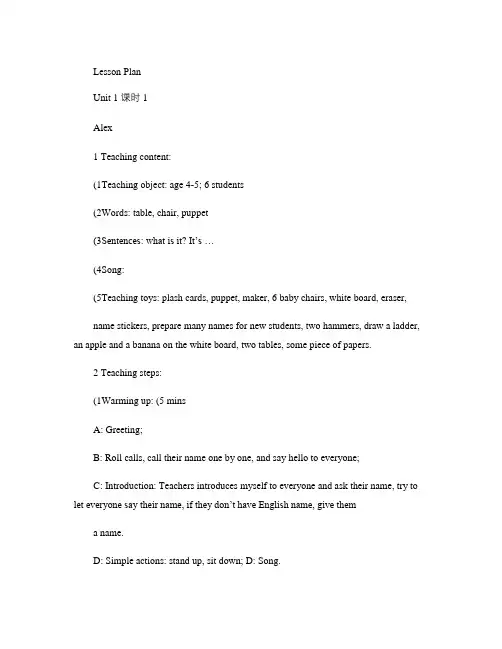
Lesson PlanUnit 1 课时1Alex1 Teaching content:(1Teaching object: age 4-5; 6 students(2Words: table, chair, puppet(3Sentences: what is it? It’s …(4Song:(5Teaching toys: plash cards, puppet, maker, 6 baby chairs, white board, eraser,name stickers, prepare many names for new students, two hammers, draw a ladder, an apple and a banana on the white board, two tables, some piece of papers.2 Teaching steps:(1Warming up: (5 minsA: Greeting;B: Roll calls, call their name one by one, and say hello to everyone;C: Introduction: Teachers introduces myself to everyone and ask their name, try to let everyone say their name, if they don’t have English name, give thema name.D: Simple actions: stand up, sit down; D: Song.(2Words presentation: (20 minsA: Words: chair, puppet, and table. Real object; flash cards; CDB: Practice for words: Together, show the flash cards one by one, loud and small sound and tone to say every word.Individual: by kissing, touching and kicking to say the word. Hammer gameGroup work: two groups, each team s students.Start single – Name – Rules – Game – The end singleSpread the flash cards on the floor, when the teacher says aword and they need to hit the word and say it. The winnercan be the teacher one time and say a word let the otherstudent hit it, besides; the winner group can have one stepup the ladder. The winner group can have two stars for eachone. Collect the flash cards and do the ends single.(10 minsC: Production: Check. Racing game; two groups. (10 minsStart single -- Name the gameRules: let a student do an example with the teacher; make two lines –the top two students hold the hammer before the teacher givethe single;When the teacher says a word the student goes and find it, andsay the word.The winner group can have two starts.Start – the end single(3Sentences presentation: (15 minsA: answer: listen to the CDB: practice: It’s …Individually: craw craw craw (game.Rules: place two tables end to end, make a line and they craw under the table from the top to the end, the teacher will waiting for them at the endof the table. The teacher says: “what is it?”T hen each kid can get a chanceto practice: It’s …Together: what is it? It’s …Group work: two groups. Keep going the ladder game.Now the students ask the teacher question. The group that louder than another one can have one step up,C: production: checkTwo teams: racing gameSingle – name – rulesRules: the teacher opposite to the students, when the teacher says goes, theyjump/craw/ hop/run to the teach er; the teacher says: “what is it?” the first one who can answer the question and jump/craw/… back to the line, they will win.Start – the end actionCommunication: five stepsRules: each student draw a picture (chair, table and puppet; the teacher ask a student do an example, the teacher says: “what is it?” the student look at the teacher’s picture and say the answer, then the student ask the teacher the question,, after that they change their picture and go to find others do the same thing; when they change one time they can get a poker. The winner could be the one have the most pokers.Start – endThe minutes breakThe second class (40 minsTeaching steps:(1Review “what is it, It’s …” (5 mins(2Letter A a B b (10 mins flash cards A a B b same hammer game.(3Hand out some pictures to the students: chair table puppet; trace A aB b. (when the students do the drawing things the teacher canreview again by individually (15 mins(4Wrap up (10mins: review all the stuff (5 mins;Line up, train game;Homework: tell their parentsGoodbye :( If some parents want to know their kids’ behavior you can let them wait after the class.。
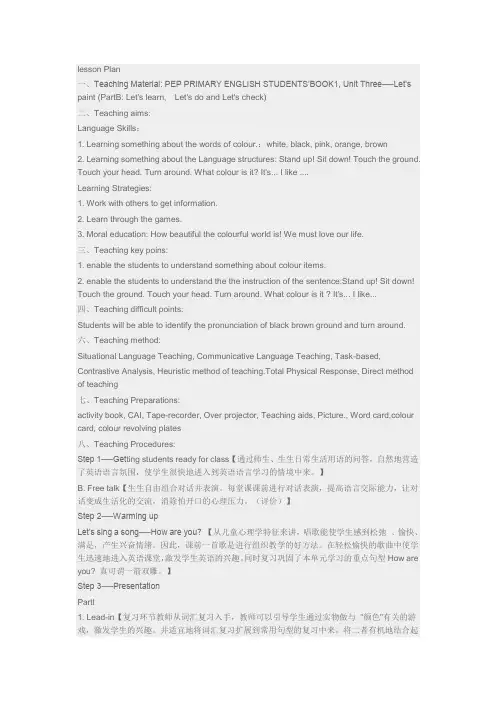
lesson Plan一、Teaching Material: PEP PRIMARY ENGLISH STUDENTS‟BOOK1, Unit Three──Let's paint (PartB: Let's learn,Let's do and Let's check)二、Teaching aims:Language Skills:1. Learning something about the words of colour.:white, black, pink, orange, brown2. Learning something about the Language structures: Stand up! Sit down! Touch the ground. Touch your head. Turn around. What colour is it? It's... I like ....Learning Strategies:1. Work with others to get information.2. Learn through the games.3. Moral education: How beautiful the colourful world is! We must love our life.三、Teaching key poins:1. enable the students to understand something about colour items.2. enable the students to understand the the instruction of the sentence:Stand up! Sit down! Touch the ground. Touch your head. Turn around. What colour is it ? It's... I like...四、Teaching difficult points:Students will be able to identify the pronunciation of black brown ground and turn around. 六、Teaching method:Situational Language Teaching, Communicative Language Teaching, Task-based, Contrastive Analysis, Heuristic method of teaching.Total Physical Response, Direct method of teaching七、Teaching Preparations:activity book, CAI, Tape-recorder, Over projector, Teaching aids, Picture., Word card,colour card, colour revolving plates八、Teaching Procedures:Step 1──Get ting students ready for class【通过师生、生生日常生活用语的问答,自然地营造了英语语言氛围,使学生很快地进入到英语语言学习的情境中来。
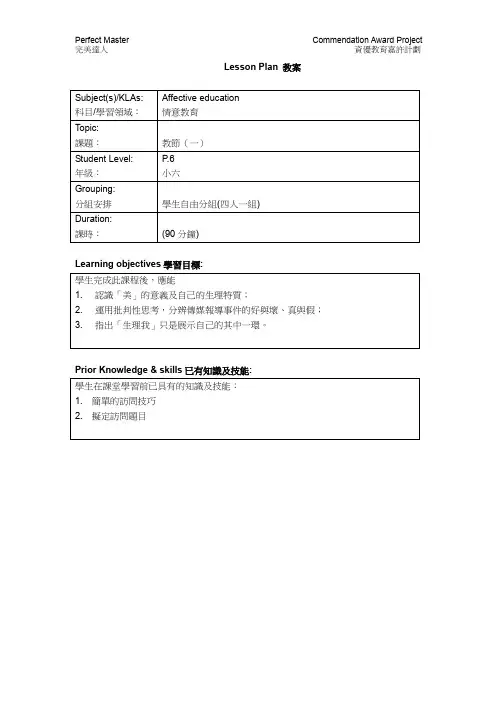
Lesson Plan 教案
Learning objectives學習目標:
Prior Knowledge & skills已有知識及技能:
教學活動及流程:
# 展示在教學活動中為照顧高能力/資優學生而調適的教學內容和策略。
學習評估:
Lesson Plan 教案
Learning objectives學習目標:
Prior Knowledge & skills已有知識及技能:
教學活動及流程:
#展示在教學活動中為照顧高能力/資優學生而調適的教學內容和策略。
學習評估:
Lesson Plan 教案
Learning objectives學習目標:
Prior Knowledge & skills已有知識及技能:
教學活動及流程:
香港進食失調康復會有限公司派員到校主講《瘦身文化面面觀》講座
全級進行
# 展示在教學活動中為照顧高能力/資優學生而調適的教學內容和策略。
學習評估:
Lesson Plan 教案
Learning objectives學習目標:
Prior Knowledge & skills已有知識及技能:
教學活動及流程:
#展示在教學活動中為照顧高能力/資優學生而調適的教學內容和策略。
學習評估:
Lesson Plan 教案
Learning objectives學習目標:
Prior Knowledge & skills已有知識及技能:
教學活動及流程:
#展示在教學活動中為照顧高能力/資優學生而調適的教學內容和策略。
學習評估:。
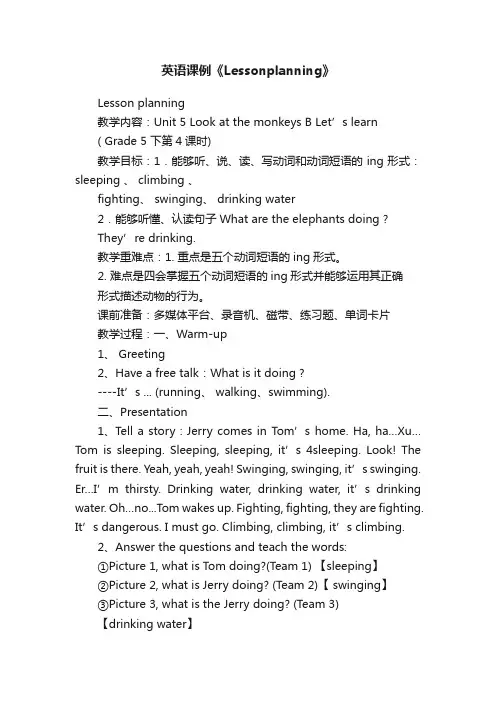
英语课例《Lessonplanning》Lesson planning教学内容:Unit 5 Look at the monkeys B Let’s learn( Grade 5 下第4课时)教学目标:1.能够听、说、读、写动词和动词短语的ing形式:sleeping 、 climbing 、fighting、 swinging、 drinking water2.能够听懂、认读句子What are the elephants doing ?They’re drinking.教学重难点:1. 重点是五个动词短语的ing形式。
2. 难点是四会掌握五个动词短语的ing形式并能够运用其正确形式描述动物的行为。
课前准备:多媒体平台、录音机、磁带、练习题、单词卡片教学过程:一、Warm-up1、 Greeting2、Have a free talk:What is it doing ?----It’s ... (runnin g、 walking、swimming).二、Presentation1、Tell a story:Jerry comes in Tom’s home. Ha, ha…Xu… Tom is sleeping. Sleeping, sleeping, it’s 4sleeping. Look! The fruit is there. Yeah, yeah, yeah! Swinging, swinging, it’s swinging. Er…I’m thirsty. Drinking water, drinking water, it’s drinking water. Oh…no...Tom wakes up. Fighting, fighting, they are fighting. It’s dangerous. I must go. Climbing, climbing, it’s climbing.2、Answer the questions and teach the words:①Picture 1, what is Tom doing?(Team 1) 【sleeping】②Picture 2, what is Jerry doing? (Team 2)【 swinging】③Picture 3, what is the Jerry doing? (Team 3)【drinking water】④Picture 4, what are Tom and Jerry doing? (Team 4)【fighting】⑤Picture 5, what is Jerry doing? (抢答) 【climbing】3、Teaching grammar: 现在进行时【be动词 + 动词ing形式】三、Practice1、Read after the tape2、Read after the teacher3、Read in the whole class4、Read in the group of 45、Check reading四、Production1、Play a game—You are mine请两名同学上来猜拳赢单词,赢得改单词的同学要带领全班读吹该单词,最后看哪个同学赢得最多的单词。
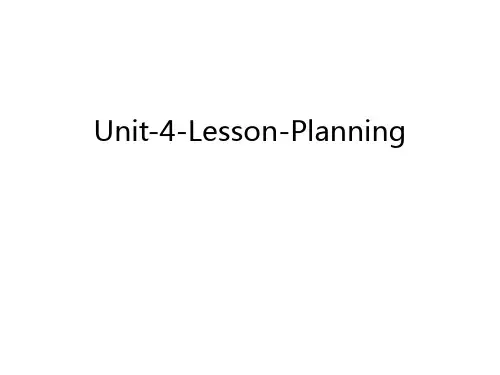

Lesson planBackground information:Students: 60 Junior high school students, Grade1Lesson duration: 45 minsTeaching objectives:By the end of the lesson, students should be able to:1.Say in English the plurals of Nouns.2.Ask and answer questions about the Nouns.e the interview Strategies to ask information and take notes.4. learn to be a good listener and brave to ask questions in English. Teaching contents: the classification of Nouns, the plurals of Nouns map---maps box---boxes sheep---shee p…Wha t’s this? ---This is a pianoHow many books are there in the desk? ---Ten books.Teaching aids: blackboard, chalk, PPT, picturesTeaching procedures:Step1. Review (10 mins)a) Students write down the Nouns they know.b) Students try to guess the plurals of the Nouns.c) Teacher summarizes, and writes the words on board.Step2.Learn the related information about Nouns: the classification of Nouns, the plurals of Nouns (20 mins)a) Use a chart to show the students the classification of Nouns.b) Learn the plurals of Nouns.c) do some exercises about Nouns.Steps3.More practice (15 mins)a) Work in pairs, and ask and answer the questions related to Nouns. Use the structure: what’s this?--- This i s…/How many are there on the desk?--- They ar e…b) V olunteers to present the result.Homework: Make some sentences and dialogues about Nouns learned in class.Reflection: (to be written immediately after the lesson).。
Lesson PlanBackground informationStudents:Junior high school students, Grade 1Lesson duration: 40minsTeaching aims:1. Knowledge aims(1) Students can know some new words about transportation and learn some sentence patterns。
(2) Students can learn some sentence patterns。
2. Ability aims(1)To develop the students’ abilities of listening, speaking, reading and writing.(2) To train the students’ ability of working in pairs.(3) To develop the students' abilities of communication by learning the useful structures.3。
Emotion aims(1) Through different teaching methods to make students be interested in study. (2) Love to know more knowledge about transportation and dare to express their opinions in English。
(3) Encourage the students to be more creative and try to make contributions to making new inventions in the future。
Lesson plan(The fourth period for Unit 6)Ⅰ. Teaching aims and requirements:1.To have students learn some new words by heart2.To have them use the sentence pattern correctly3.To develop student’s abi l ity to express and build their consciousnessof environment protection.Ⅱ.Teaching contents:Book ⅠUnit 6 B Let’s learn1.New words and expressions: village, house, tree, bridge, building.2.sentence pattern: --There be …--Are there any …? --Yes, there are. /No, there aren’t.Ⅲ.Teaching key and difficult points:1.key points :1).words and phrases.2).can ask and answer the sentence pattern.2. difficult points:practice speaking with the target language in the created linguistic circumstances.Ⅳ.Teaching aids :cards, blackboard, coursewareⅤ.Teaching procedures ;Stage 1: Warming up and revision.(1).greetings.(2).revision: review the language points in Unit 5.Stage 2: Leading-inT: today we’re in a new classroom. What’s in the classroom? Let’s find out.T: There is a computer in the new classroom. Right? What else do you find? (encourage students to raise hands and say it out)S1:…S2 :…T: Very good! You’ve found many things. Let’s look at the nature park. What’s in the nature park? Today we’ll learn Unit 6, part B, Let’s learn. Stage 3.presentation:1. New words teachingT: First let’s learn some new words.(1).teach the word “tree”a. Show a picture of a tree and teach the new word, then encourage students to make sentence with it.E.g. there is a tree in the picture.b. Practice the word and write on the board.(2). teach the word “bridge”a. show a picture about “bridge” and try to practice .T: What’s this in Chinese?S:”桥”T: Good! It’s bridge .Look; there is a bridge over the river.(ask students to pay attention to over the river.)b. ask students to think about the bridge in Lanzhouuse the same way to teach the words “building ,house ,village”(3) repeat the words1) follow the teacher.(change the cards to read)2).play a game. “Loud voice and low voice”3) practice: Fill in the blanks.2. Sentence teachingT; Look at the picture. This is a nature park. What’s in the nature park? Encourage students to use “There be….”to make sentences.S:…T: Well done! Look, there is a lake on the mountain .Listen carefully; Are there any lakes on the mountain?(Encourage students to say: Yse, there is. And write down on the blackboard.)Ask students to look at the dialogue in the picture and read after the tape. Stage 4.Practice(1).controlled practice:1) Repeat the sentence following the tape. (read in groups)2)practice more with “Are there any…?” (talk about the other things in the nature park.) Then invite some students to act their dialogues. (2).Free practiceWork in groups and talk about things around us. Then invite some pairs to show their dialogues.Stage 5 Consolidation(1).review the wordsT: close your eyes .let’s think .what’s in the nature parkS: Mountains, trees …(2).sum up “Are there any +可数名词复数+地点?”Stage 6: homeworkFinish the exercise on the screen and make up 3 dialogues.Ⅵ. Blackboard design:。
英语教学l e s s o np l a n-CAL-FENGHAI-(2020YEAR-YICAI)_JINGBIANLesson PlanI. Teaching material and learning condition1. The analysis of teaching materialThe teaching material is from Go For It Book 8A Unit 10 section A. The topic of this unit is about future intentions. The passage is a dialogue between a boy and a girl about …... Besides, there are some useful expressions. So in this lesson, students are going to learn 6 new words and some key sentence patterns.2. The analysis of learning conditionThe students are from grade 2 in junior high school. As junior high school students, they have acquired some words about jobs. Even though the topic future intention is familiar to them, still some of the Ss can’t ask others about their future intentions accurately and fluently. With the limited vocabulary, the students may lack of rich words to show their dreams. However, the passage 1a and 1c offer nice models for students to imitate.II. Teaching aims1 Knowledge aims(1) By the end of the class, the students are able to understand the passage.(2) T he students are able to use the sentence patterns” What are you going to be…”“I’m going to be a/an…”“How are you going to do that?”“I’m going to…”(3) The students are able to master the new words: computer programmer, professional basketball player, pilot, engineer, teacher and actor.2 Ability aims(1) The students are able to read the passage clearly and fluently.(2) The students are able to use the key sentence patterns to make conversations.(3) The students are able to listen, speak, write and use the new words and understand other words about jobs mentioned in our class.3 Affect aimsStudents will know the features of jobs and have their own future plan. What’s more, they will aware of that only when they work hard, can they achieve their dreams.Language focuses and anticipated difficulties1 Language focusesThis is a listening and speaking period so the focus is to cultivate the students’ listening and speaking skills. The many activities are designed to help Ss to train their listening and speaking skills, such as pair work, ask and answer, listen to the tape and fill in the blanks.It is also important for the Ss to master the new words and target language.2 Anticipated difficultiesAs the Ss have a limited vocabulary, so they may have difficulty in using the new words naturally and fluently in real situations. Besides, they may have problems in using the key sentence patterns naturally and fluently in making conversations.3 SolutionsBased on the different circumstances, I’ll adopt different solutions. For example, if Ss can’t use target language to make dialogues naturally, I’ll let them practice more and speak more in the class.Teaching methodWell, how to achieve the teaching goals better, to stress the key points and break through the difficult pointsThe key is how to make use of the proper teaching methods.So in this lesson, I plan to use Communicative language teaching, Situational language teaching, Task-based language teaching, The Audio lingual language teaching and CAI.Teaching aidsTapes, blackboard, chalks, multimedia devices and PPT documents: In order to help Ss to fully understand the whole passage, I adopt multimedia devices and PPT documents to bring the real-life situation into the classroom. Teaching proceduresStep1 Warm-up (6min)Activity 1 Watch a video frequency about basketball player Activity 2 Free-talkingAfter watching the video frequency, teacher asks the Ss:” Do you know what are they”, “Do you like playing basketball”” Do you want to be a basketball player?” and so on. Ss answer the questions individually. Then teacher leads into the topic: future intentions.Purpose: In this step, teacher first shows a video frequency, and then leads in the topic by talking with the Ss freely. It will help to arouse the Ss' participation desire, and lead the Ss into a relaxing English studying atmosphere at the beginning of the class. Good beginning is half done. And the most important purpose is to show the main clue of the whole class.Step2 Presentation and practice (22min)Activity 1 Present key words with pictures one by oneBefore presenting the new words, teacher shows Ss pictures of jobs and ask them questions, “what is he/she?” after answering questions, teacher presents the new words in the same PPT and teach Ss the pronunciation and spelling.Activity 2 BrainstormingTeacher designs a game for Ss. T divides the whole class into 4 groups, each group chooses a representative. The 4 Ss come to the blackboard and write down the jobs they know. Which one writes the most, his group wins. This is a kind of brainstorm; it can help arouse students’ interest of study.Activity 3 Present key sentence structure and passageT displays key sentence structures:” What are you going to be…”“I’m going to be a/an…”“How are you going to do that?”“I’m going to…”Above all, all the language points have been shown. Then T will present the passage and let Ss read it together.-“What are you going to be when you grow up?”-“I’m going to be a computer programmer.”- “How are you going to do that?”- “I ’m going to study computer science.”Activity 3 Pair workT shows Ss pictures about several jobs, puts on some phrases on the PPT.Ss make dialogues according to the pictures and phrases.For example: What are you going to be when you grow up? A pilotHow are you going to do that Learn more about science exercise everydayActivity 4 what do you think of these jobsT let Ss do the exercise as follows:Do you think these jobs are interesting? Rank them from [1--6] (1 is mostinteresting, 6 is least interesting.)___ Computer programmer___ Baseball player___ Pilot___ Engineer___ Teacher ___ ActorActivity 5 Listen to the tape and fill in the blanksT let Ss listen to the tape and finish the exercise in the textbook. It can make the students concentrate on the listening materials.Step3 Consolidation (10min)It’s important for students to speak English as much as possible in class orafter class. So in this part, I show students a picture. Students are required towriterteacher pilotactor interesting difficult (hard)easy boring excitingpractice the conversation in the picture. Then they make conversations aboutthe other jobs.Model: A: What are you going to be when you grow up?B: I’m going to be a reporter.A: How are you going to do that?B: I’m going to write articles and send th em to magazines and newspapers.A: When are you going to start?B: I’m going to finish high school and college first.A: Where are you going to work?B: I’m not sure. Maybe Beijing or Shanghai.A: Good luck!B: Thank you!Step4 Extension (6min)It’s ne cessary for Ss to do some extensive exercise in class to strengthen the knowledge they learned. So in this step, I display some exercises to let themmaster the new words and target sentence structures better.Exercise A1. I like computer. I’m g oing to be a c________ ____________.2. The actor ___going to New York.3. How ____you going to do that4. The boys___ _____ ___ play soccer.5 .___there ______ to ____ a fashion showExercise BA: (1) ______________________B: I'm going to buy a present(礼物).A: (2) __________________________B: I'm going to give it to my English teacher.Exercise C1—Are you going to be _____ actor?—Yes. I’m taking _____ acting lessons.A. a; theB. an; 不填C. the; anD. 不填; the2. —_____ are you going to keep healthy?—I’m going to exercise every morning.A. HowB. WhereC. WhyD. When3. —where are you going to live?—_____. Maybe Beijing or Tianjin.A. Yes, pleaseB. I’m not sureC. Don’t worryD. Good idea4. —My New Year’s resolution is to learn to play an instrument.—_____A. Sounds great.B. Sorry to hear that.C. What about you?D. Sure, I’d love to.Step5 Homework (1min)In order to let the Ss to review the learned knowledge and speak English more after class, I assign the homework as follows:1. Copy the new words.2. Write a composition about your plans for the future.3. Read the passage in the textbook after the tape.Blackboard design08051129 华夏怡。
竭诚为您提供优质文档/双击可除lesson,plan,模板篇一:lessonplan模板lessonplanunit2lesson1aperfectday(示例)本课是第xx单元第xx课。
本单元围绕xxx话题。
本课计划按两次课完成:第一次课关于warmingupandreadingcomprehension;第二次课xxxxx。
......(示例)period1:warmingupandreadingcomprehension(示例)(90min)objectives1.knowledgeobjectives:1)masterthenewwordsandexpressions2)tousetimelinkers,especiallyadverbsandconjunctions2.abilityobjectives:1)learnaboutthegeneralideaofthetextthroughfastreadi ng2)findoutthedetailedorspecificinformationthroughint ensivereading3)practicestudents’abilitytousethestrategyofpredicationandreference3.emotionobjectives:1)tolearntheheroicspiritofyangliwei2)togetandarrangetheinformationaboutspaceship3)todescribetheprocessoftheflightandthefeelingsofya ngbythewordsandexpressionslearnedinthislesson(此部分可根据实际情况删减)contents1.words:astronaut,flight,launch,rocket,atmosphere,helicopte r,parachute,gravity,manndspaceship,separate…from,becauseof,letout,millionsof......2.expressions:separatefrom与……分离,becauseof因为,由于,liftoff起飞,升空,发射......3.sentences:1)thespaceship,calledshenzhouⅤ,wascarryingchina’sfirstastronaut,yangliwei.2)whenthespaceshipwasdoingitsseventhcircle,yangliwe ishowedtheflagsofchinaandtheunitednations,expressin gthewishesofthechinesepeopletoexploreandusespacepea cefully.municativetasks:questionscanbebasedondetailsin thetext.whydopeoplethinkyangliweiisaherowhatcanwelearnfromyangliwei ……keypointsanddifficulties1.findoutthemainideaanddetailedinformationthroughex tensiveandintensivereading.2.todescribetheprocessoftheflightbythewordsandexpressionslearnedinthislesson.teachingapproachestask-basedteaching,scanning,intensivereading,rolepl ay,pair-worksdebutlaunch.长征七号运载火箭20xx年6月25日晚在海南文昌发射场首飞成功。
Lesson planUnit 5 Traveling AbroadPeriod 1 Warming-up and readingTime: 45 minutesThe number of students: 50The grade of students: grade two in high school1.The analysis of teaching materials:This unit forms a part of high school English teaching material, Student’s Book 7. This unit can be divided into three parts: warming-up, reading, listening about language. Its main topic is traveling abroad and it contains two reading materials, studying in foreign country and traveling in foreign country. Today,we will learn the first part, studying in a foreign country. In this unit, it tells students what problems they will meet in foreign countries and how to deal with these problems. Also, it introduces the benefits and difficulties of studying abroad through the story of Xie lei.2.The analysis of students:As high school students, they have learned English for several years and they have a basic command of English. Students will be interested with a certain topic easily, such as traveling, sports healthy life and so on, which adapts to their physical and psychological characteristics. Additionally, students are weak in English speaking, so in my class, I will design some questions and activities for them to practice their pronunciation.3.Teaching aims:Knowledge aim:a)Students will learn about Xie L ei’s school life in London.b)Students will learn new words and phrases including lecture,academic, comfort, requirement, acknowledge, preparation, contradict, occupy, recommend, substitute.Ability aim:a)Students will be able to use the new words about traveling abroadto describe the life in foreign countries.b)Students will be able to think of their own way to deal with thepossible problems of living abroad.c)Students will be able to know how to read the news report and getthe main idea by finding the key information about what, when, why, where and who.Emotion aim:a)Students will be more interested in traveling or studying abroad.b)Students can overcome the difficulties in study and life afterreading Xie Lei’s story.Learning strategy aim:a)Students will learn about the characteristics of the news reportand get the main idea by finding the main words, who, when, where, why, what.Culture aim:a)Students will gain more knowledge about the lifestyle and theweather feature in London.2.Key point:a)Learning the new words and phrases about traveling abroad and knowtheir meanings, such as requirement, acknowledge, preparation, fit in.b)Learning about the benefits and difficulties of studying abroad.3.Difficult point:a)Grasping the ability to skim and scan the text and the ability tosummarize the main idea of each paragraph. It requires students to summarize the main idea according to find the key information about what, when, why, who, where.b)Learning the basic structure of emphatic sentence and how to useit. It requires students to be able to use it in the composition.4.Teaching aids:Power Point, a blackboard, some chalk, a tape recorder5.Teaching methods:Task-based language teaching6.Teaching procedure:Step1 Lead-in (4 minutes)At first,the teacher will ask students a question, if you have a chance to go abroad in the world, which country would you like to go? Why? Fifteen seconds later, the teacher will choose two students to tell their answers. After hearing these answers, the teacher will show some beautiful pictures of different countries to attract students’ attention, such as Statue of Liberty, Sydney Opera House, Eiffel Tower and so on(5 slides)and next the teacher will ask students whether they want to go abroad to have afurther study or not.Step2 pre -reading(6minutes)Nowadays, more and more students wants to go abroad to have a further study. What are the advantages and disadvantages of studying abroad? Then the teacher will ask students to discuss in the four-people group.Suggested answers:T:”You are going to read a newspaper article about a Chinese student who goes to study in England. What do you think she willfind differences from studying at a Chinese school/university?”Step3 listening and fast reading (5minutes)1. Listen to the tape and find the answers to the following questions.1)Who is the main character?2)Will she overcome difficulties at last? Who helps her?3)What is Xie Lei in England for? How long has she beenin England?2. True or False.a.When Xie Lei went to New York, she felt very excited and relaxed.b.Xie Lei came to the university to complete a sciencequalification.c.Xie Lei lives in the student accommodation.d.Xie Lei found the preparation course was very easy tolearn at first.e.Xie Lei’s tutor helped her a lot in her study.Step4 detailed reading (12minutes)1.Summarize the main idea of the passage (the teacher will give students three minutes to skim the whole text and summarize the main idea)Suggested answer:The text mainly tells us a Chinese student named Xie Lei is studying at an English university, which introduces us her study life there and how she solved the difficulties she faced.2. Put the events into order_3__The difficulties Xie Lei met while living in London;_7__The newspaper will follow Xie Lei’s progress in later editions._2__The general introduction to Xie Lei and her study;_1__The advantages that Xie Lei gained while living with a host family._6__Xie Lei is now getting along well and is living an act ive life._4__ Xie Lei, a Chinese girl, is studying in a foreign c ountry--London._5__Xie Lei is getting used to the Western University’s way of learning.3.Answer questions( The teacher will invite four volunteers to answer the four questions)1)Why is she doing a preparation course first?2)What are some of difficulties she faced when she firstcame to England?3)Why does Xie Lei have such a decision that she would like to board with a host family while studying in Engla nd?4)How does Xie Lei try to get used to the new sociallife in England?Step5new words(8minutes)Firstly, the teacher will ask students to find out the new words in the first two paragraphs when they are reading it. Next, the teacher will check the new words that students find in the two paragraphs. Then the teacher will explain its meaning in the text and he will also expand its relevant phrases.For example:Step6 text analysis (9minutes)The teacher will write the example of emphatic sentence in the blackboard and tell students what an emphatic sentence is and then the teacher will ask students to make other sentences according to the sentence in the blackboard. Next, students will finish four single-choice questions about this grammar point in the PowerPoint. (强调句详情在幻灯片上可见)课文原句:It’s not just study that’s difficult.It is/ was + 被强调部分(通常是主语、宾语或状语)+ that/ who(当强调主语且主语指人)+ 其他部分。
Lesson planUnit 5 Traveling AbroadPeriod 1 Warming-up and readingTime: 45 minutesThe number of students: 50The grade of students: grade two in high school1.The analysis of teaching materials:This unit forms a part of high school English teaching material, Student’s Book 7. This unit can be divided into three parts: warming-up, reading, listening about language. Its main topic is traveling abroad and it contains two reading materials, studying in foreign country and traveling in foreign country. Today,we will learn the first part, studying in a foreign country. In this unit, it tells students what problems they will meet in foreign countries and how to deal with these problems. Also, it introduces the benefits and difficulties of studying abroad through the story of Xie lei.2.The analysis of students:As high school students, they have learned English for several years and they have a basic command of English. Students will be interested with a certain topic easily, such as traveling, sports healthy life and so on, which adapts to their physical and psychological characteristics. Additionally, students are weak in English speaking, so in my class, I will design some questions and activities for them to practice their pronunciation.3.Teaching aims:Knowledge aim:a)Students will learn about Xie L ei’s school life in London.b)Students will learn new words and phrases including lecture, academic,comfort, requirement, acknowledge, preparation, contradict, occupy,recommend, substitute.Ability aim:a)Students will be able to use the new words about traveling abroad todescribe the life in foreign countries.b)Students will be able to think of their own way to deal with the possibleproblems of living abroad.c)Students will be able to know how to read the news report and get themain idea by finding the key information about what, when, why, whereand who.Emotion aim:a)Students will be more interested in traveling or studying abroad.b)Students can overcome the difficulties in study and life after readingXie Lei’s story.Learning strategy aim:a)Students will learn about the characteristics of the news report and getthe main idea by finding the main words, who, when, where, why,what.Culture aim:a)Students will gain more knowledge about the lifestyle and the weatherfeature in London.2.Key point:a)Learning the new words and phrases about traveling abroad and knowtheir meanings, such as requirement, acknowledge, preparation, fit in.b)Learning about the benefits and difficulties of studying abroad.3.Difficult point:a)Grasping the ability to skim and scan the text and the ability tosummarize the main idea of each paragraph. It requires students tosummarize the main idea according to find the key information aboutwhat, when, why, who, where.b)Learning the basic structure of emphatic sentence and how to use it. Itrequires students to be able to use it in the composition.4.Teaching aids:Power Point, a blackboard, some chalk, a tape recorder5.Teaching methods:Task-based language teaching6.Teaching procedure:Step1 Lead-in (4 minutes)At first,the teacher will ask students a question, if you have a chance to goabroad in the world, which country would you like to go? Why? Fifteen seconds later, the teacher will choose two students to tell their answers. After hearing these answers, the teacher will show some beautiful pictures of different countries to attract students’attention, such as Statue of Liberty, Sydney Opera House, Eiffel Tower and so on(5 slides)and next the teacher will ask students whether they want to go abroad to have a further study or not.Step2 pre -reading(6minutes)Nowadays, more and more students wants to go abroad to have a further study. What are the advantages and disadvantages of studying abroad? Then the teacher will ask students to discuss in the four-people group.Suggested answers:T:”You are going to read a newspaper article about a Chinese student who goes to study in England. What do you think she will find differences from studying at a Chinese school/university? ”Step3 listening and fast reading (5minutes)1. Listen to the tape and find the answers to the following questions.1)Who is the main character?2)Will she overcome difficulties at last? Who helps her?3)What is Xie Lei in England for? How long has she been in England?2. True or False.a.When Xie Lei went to New York, she felt very excited and relaxed.b. Xie Lei came to the university to complete a science qualification.c. Xie Lei lives in the student accommodation.d. Xie Lei found the preparation course was very easy to learn at first.e.Xie Lei’s tutor helped her a lot in her study.Step4 detailed reading (12minutes)1.Summarize the main idea of the passage (the teacher will give students three minutes to skim the whole text and summarize the main idea) Suggested answer:The text mainly tells us a Chinese student named Xie Lei is studying at an English university, which introduces us her study life there and how she solved the difficulties she faced.2. Put the events into order_3__The difficulties Xie Lei met while living in London;_7__The newspaper will follow Xie Lei’s progress in later editions._2__The general introduction to Xie Lei and her study;_1__The advantages that Xie Lei gained while living with a host family._6__Xie Lei is now getting along well and is living an active life._4__ Xie Lei, a Chinese girl, is studying in a foreign country--London._5__Xie Lei is getting used to the Western University’s way of learning.3.Answer questions( The teacher will invite four volunteers to answer the four questions)1)Why is she doing a preparation course first?2)What are some of difficulties she faced when she first came to England?3)Why does Xie Lei have such a decision that she would like to board with ahost family while studying in England?4) How does Xie Lei try to get used to the new social life in England?Step5new words(8minutes)Firstly, the teacher will ask students to find out the new words in the first two paragraphs when they are reading it. Next, the teacher will check the new words that students find in the two paragraphs. Then the teacher will explain its meaning in the text and he will also expand its relevant phrases.For example:Step6 text analysis (9minutes)The teacher will write the example of emphatic sentence in the blackboard and tell students what an emphatic sentence is and then the teacher will ask students to make other sentences according to the sentence in the blackboard. Next, students will finish four single-choice questions about this grammar point in the PowerPoint. (强调句详情在幻灯片上可见)课文原句: It’s not just study that’s difficult.It is/ was + 被强调部分(通常是主语、宾语或状语)+ that/ who(当强调主语且主语指人)+ 其他部分。